
Visual Storytelling in Movies: Understanding Videos with Emotion AI
Movies are an art form that can move, entertain, and inspire audiences through visual storytelling. The fusion of AI in the film industry and visual storytelling in movies is transforming how films connect with audiences on an emotional level.
Movies aren't just stories; they are emotional journeys that invite us to explore the depths of our feelings and humanity.
Do you know the movies we watch may have an impact on our emotional landscapes and our understanding of the human psyche?
Well, they have the power to inspire, provoke thought, and even shape our perspectives on life.
Numerous elements contribute to a movie's greatness, such as a compelling story, memorable music, and intriguing characters. But let's consider this: can any of these elements shine without the presence of emotions?
In storytelling, whether a narrative aims to evoke feelings of happiness, sadness, or excitement, a crucial element in achieving these emotional responses is the ‘characters’ within the story. These characters connect with the audience and drive the emotional impact of the narrative.

The emotional connection between the audience and the characters is the key to engaging viewers on a deeper psychological level. With the rise of visual storytelling in movies, technology now assists in decoding these emotional connections. AI for filmmaking delves into how characters’ emotions resonate with the audience, analyzing facial expressions and behaviors to enhance storytelling. This collaboration between human creativity and AI in the film industry ensures films evoke emotions that leave lasting impressions, offering insights that shape future productions.
When viewers feel a strong connection to the characters and their emotions, it not only captivates their attention but also leaves a profound and lasting impact on their own emotional experience.
If you've just watched a hilarious movie from start to finish, and a friend asks you for your thoughts on it, what's your immediate response? Your response might be something like, "It was really funny!" or "I couldn't stop laughing throughout the whole movie!"
If the film wasn't funny, you might respond with, "Honestly, it wasn't amusing. I was expecting more humor.” This is a common scenario, and indeed, it poses one of the most significant challenges for filmmakers.
When we recall heart-wrenching scenes, we can still feel their intensity in the present moment. This signifies that those scenes were emotionally charged and successfully resonated with the viewers' hearts.
Emotion AI, or Emotion Recognition Technology, is a cutting-edge tool that enhances our understanding of the emotional insights within the content (movie). Emotion AI tools like Imentiv AI, serve as a technological bridge, enabling analysis of the emotional nuances portrayed by the characters on-screen. Much like how we, as viewers, connect with the movie characters on an emotional level, Emotion AI delves into the emotions of the video frame by frame, and actor by actor.
Here's a collection of 5 iconic Hollywood movie clips, each analyzed with Imentiv AI to gain deeper insights into the emotions and psychology they evoke.
Let's explore the emotional richness of these cinematic moments one by one.
1. Forrest Gump's Simplicity: A Profound Impact on Audiences
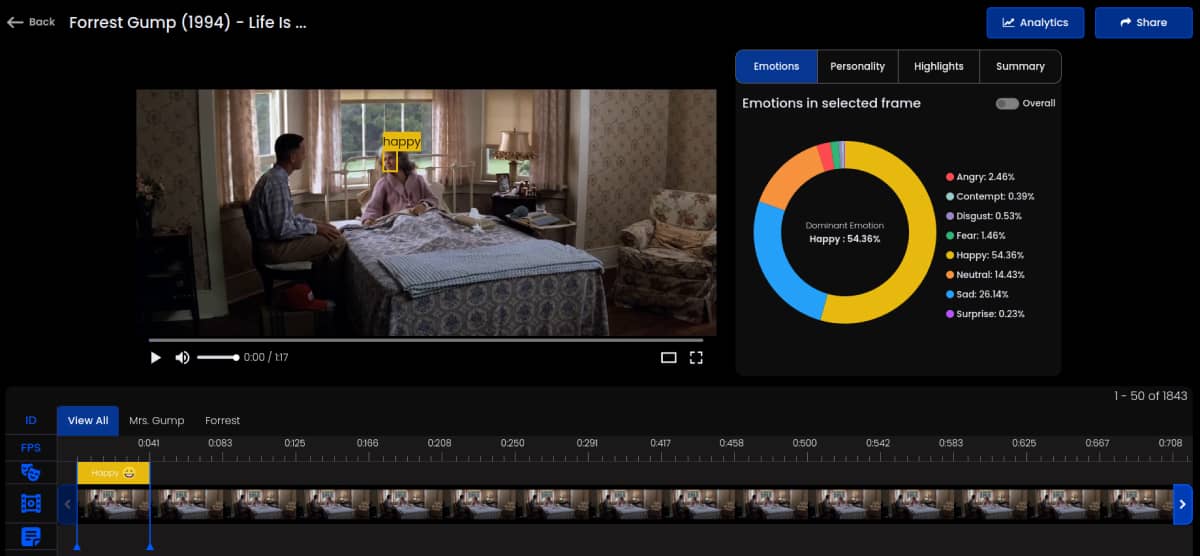
The story follows the life and adventures of Forrest Gump, a man with ostensibly low intelligence but a kind heart, as he unintentionally becomes a part of various historical events in the United States during the 20th century. "Forrest Gump" remains memorable due to its emotional impact on audiences. Many iconic scenes from the movie still resonate with people, highlighting its enduring emotional appeal.
Analyzing a specific clip from "Forrest Gump," our Emotion AI technology reveals insights into the film's emotional intricacies. In this scene, we dissect the characters' expressions, the musical score's influence, and the overall mood to showcase how emotion intertwines with storytelling, creating a powerful cinematic experience that resonates with audiences.

In this video, facial expressions serve as windows into human psychology, like how they stir up various emotions. The sad moments evoke feelings of sorrow and empathy, connecting us with others' emotions. Neutral scenes offer a sense of calm or detachment, portraying a state of balance in our minds.
However, the most intriguing moments are the bittersweet ones, where both joy and sadness coexist, reflecting the complexity of our emotions. This mixture may resonate with your own experiences of having mixed feelings, highlighting how our emotions intertwine and how our minds navigate life's intricacies.
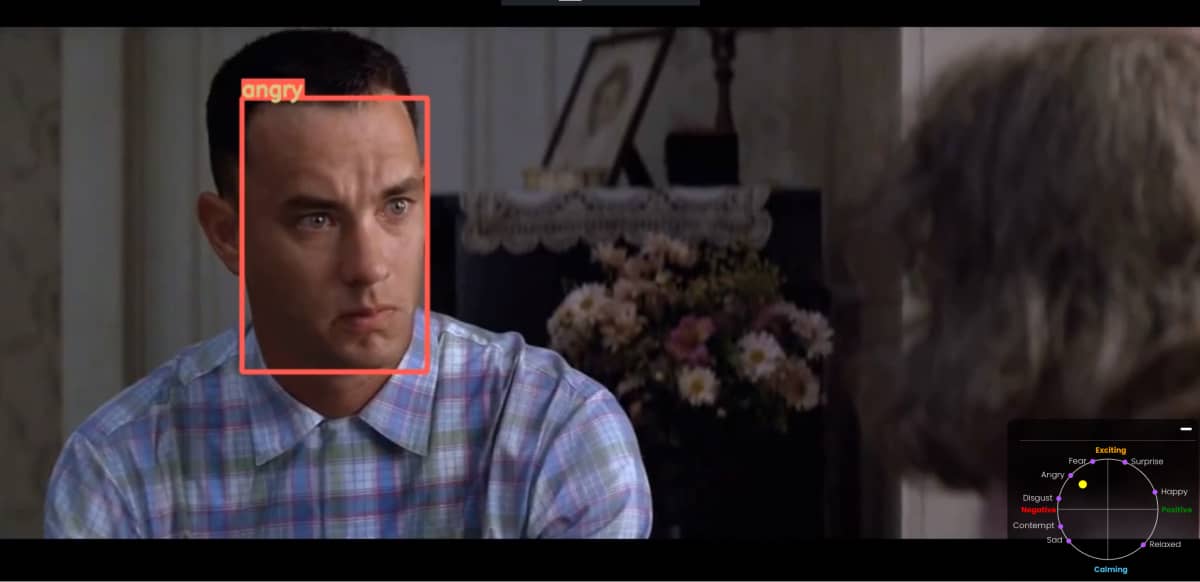
This video enhances our understanding of human emotions through facial expressions and how our minds handle life's diverse experiences.
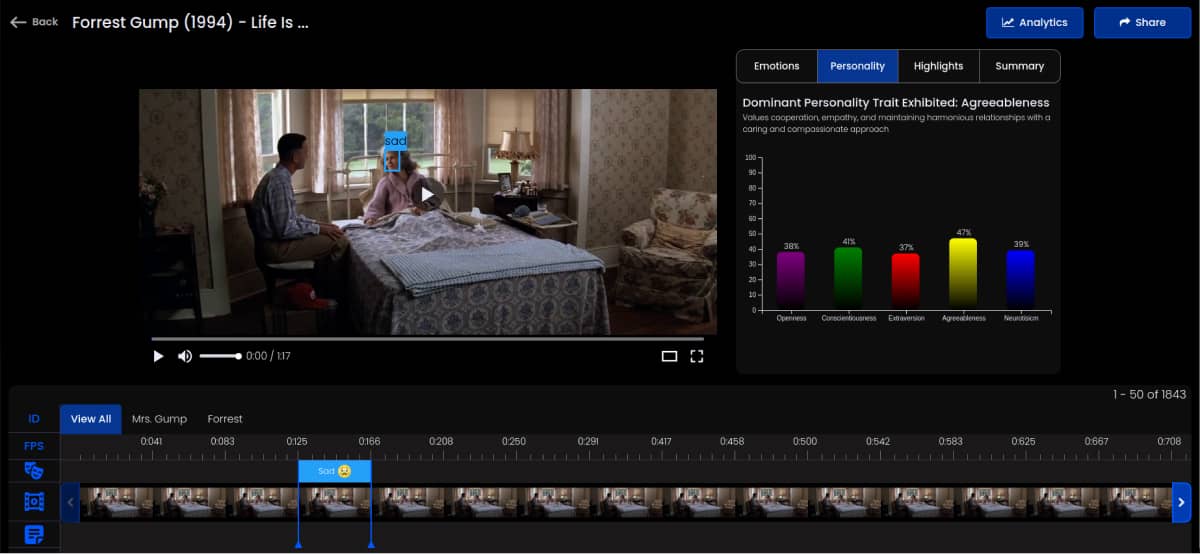
In a video where both agreeableness and conscientiousness shine, viewers are likely to observe distinct personality traits. High levels of agreeableness manifest as compassion, empathy, and a strong inclination toward cooperation and harmonious relationships. Their role in the video may involve acts of kindness, empathetic responses to emotional situations, or adept conflict resolution.
Simultaneously, a pronounced conscientiousness trait suggests a strong sense of responsibility, organization, and meticulous attention to detail. Those with high conscientiousness are often viewed as reliable, disciplined, and goal-oriented individuals.
The synergy between high agreeableness and conscientiousness fosters an environment of cooperation and trust. These individuals are dependable and trustworthy, consistently fulfilling their commitments and offering assistance when needed.
2. The Shining

Stanley Kubrick's "The Shining" is a haunting cinematic masterpiece, brilliantly unraveling the complexities of human emotions and psyche. Based on Stephen King's novel, it explores the psychological horrors of isolation, madness, and the supernatural.
The film's lasting impact is due to Kubrick's precise direction, Jack Nicholson's iconic performance, and the unsettling Overlook Hotel. Its plot, unsettling visuals, and atmosphere make it a milestone in horror cinema, probing themes of family, violence, and the thin line between sanity and madness.

Scientifically fear is a fundamental human emotion that has deep evolutionary roots. It's a survival instinct hardwired into our psyche. When we watch something fear-inducing on screen, it directly taps into this primal aspect of our humanity. This connection makes us feel more alive, as it's an emotion we've evolved to experience in response to threats or danger. This primal link to our survival mechanisms makes fear in films highly engaging.
Psychologists have noted that in videos when villains display extreme happiness during scary moments, it creates a psychological puzzle that makes the fear even more intense. The contrast between the villain's joy and the frightening backdrop increases our discomfort. This plays on our basic instincts, making us more open to surprises and elevating the fear and tension in the video.

Personality analysis of 'The Shining' reveals that the combination of agreeableness and openness traits results in a video that not only invites viewers with its agreeable demeanor but also challenges them intellectually, sparking curiosity and critical thinking.
This blend of emotional engagement and intellectual stimulation can foster a strong sense of community among the audience, encouraging collaboration and the acceptance of different viewpoints.
Mostly, videos with high agreeableness and openness leave a lasting impression, providing both emotional resonance and opportunities for personal growth and learning.
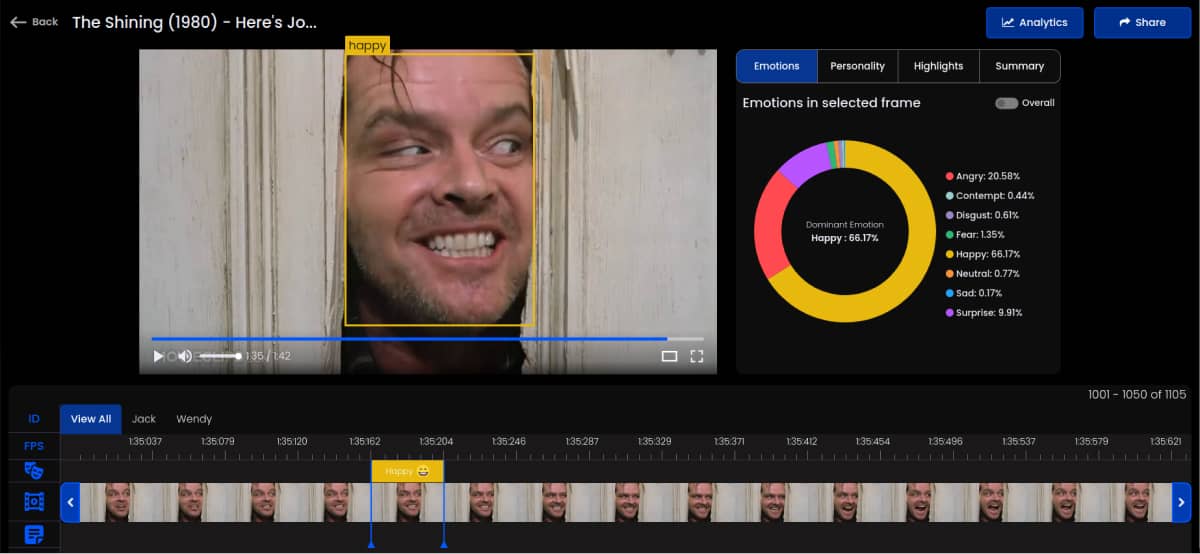
Horror films, such as “The Shining” offer a unique psychological experience. They act as a safe space for most viewers to confront their inner fears and anxieties, purging pent-up negative emotions. This concept, known as catharsis, provides a therapeutic outlet, offering a chance for emotional release and resolution.
By connecting with the antagonist's challenges, viewers can navigate their fears and eventually discover a form of psychological relief through the movie's resolution. It's worth acknowledging that individuals dealing with intense fear and anxiety might consider avoiding such genres until their psychological concerns are addressed.
Artificial intelligence in movie production provides a deeper analysis of psychological elements, such as fear and madness, contributing to the film's legacy. By examining facial expressions and emotional shifts throughout scenes, AI for filmmaking unlocks new storytelling dimensions. This synergy between technology and creativity offers fresh perspectives, engaging viewers emotionally and intellectually while encouraging filmmakers to explore new artistic frontiers.
3. Godfather
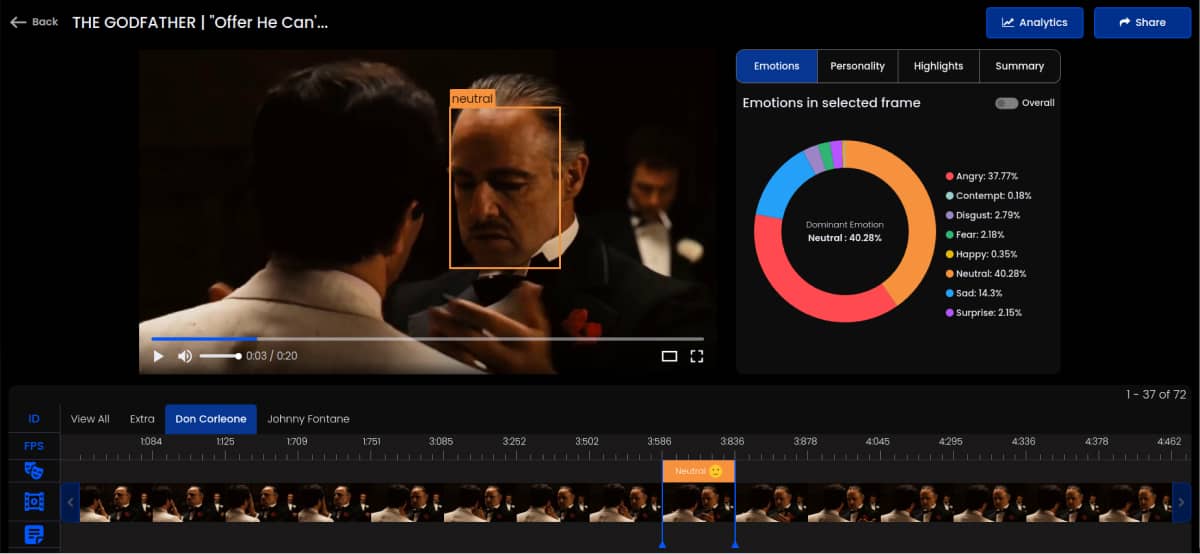
"The Godfather," directed by Francis Ford Coppola and released in 1972, is an iconic crime drama film featuring Marlon Brando, Al Pacino, and James Caan. The story delves into the Italian-American Mafia and follows the powerful Corleone family. It's celebrated for its masterful storytelling, memorable performances, and the famous line, "I'm gonna make him an offer he can't refuse."
The film's exploration of power, loyalty, and the consequences of organized crime has had a profound impact, immersing audiences in a world of complex moral choices and family dynamics within the underworld.
In a highly charged emotional scenario, a neutral facial expression becomes a captivating focal point in the video. This element grabs our attention, as it plays with our visual and emotional senses. The contrast between the serene exterior and the concealed tension piques our curiosity, compelling us to delve deeper.
We get drawn into the story as we try to understand why someone stays calm even when they're going through something tough inside. This curiosity keeps us interested and makes us want to find out what's going on.
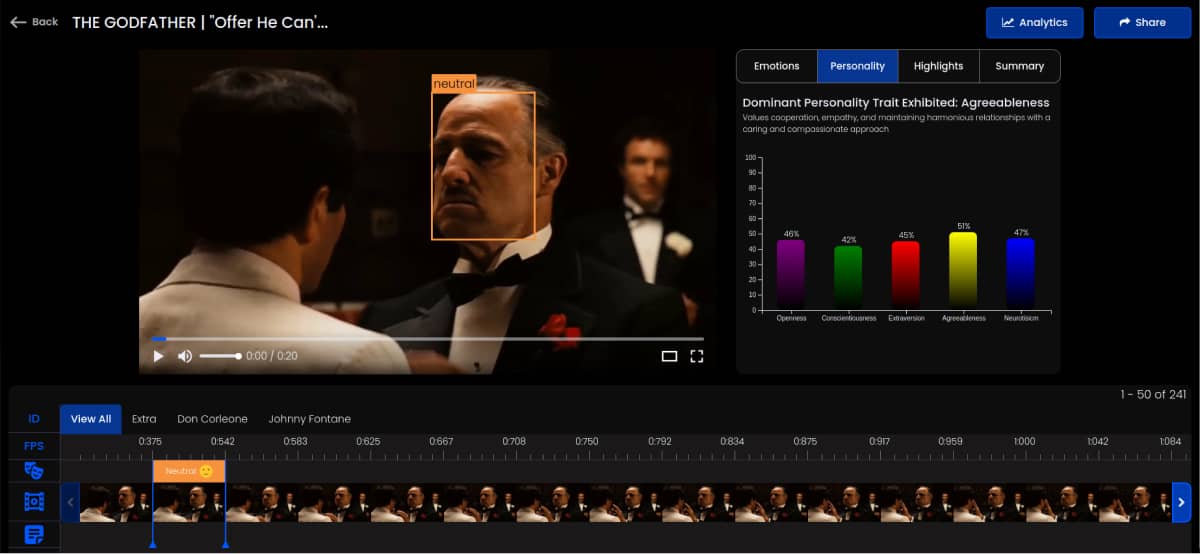
The personality analysis of this video says that when a video exhibits high levels of agreeableness, neuroticism, and openness, it introduces a mix of emotional intensity and drama to the content. This combination can elicit strong emotional reactions from viewers who seek cathartic experiences but might simultaneously divide those seeking a more stable viewing experience.
Conversely, when a video showcases high openness, it encourages intellectual curiosity, creativity, and a willingness to explore unconventional ideas or perspectives. It's the harmonious interplay of these traits that collectively shape the video's overall personality, ultimately influencing its appeal to a broad and diverse audience.
4. Titanic

The exquisite heart of the ocean, a blue diamond necklace, becomes more than just a prized jewel in the film "Titanic." It becomes a symbol of desire, luxury, and ultimately, loss. Titanic, the epic film directed by James Cameron, is a masterful cinematic portrayal of human emotions. This monumental tale of love, tragedy, and survival explores the depths of human feelings, from the ecstasy of newfound love to the despair of impending disaster.
In this iconic scene in Titanic, the emotions of Jack and Rose mirror those felt by the viewers, taking them on an emotional journey that sails alongside the magnificent ship across the endless ocean.
The primary emotion conveyed in this video is happiness. It features a romantic connection between two characters, filled with expressions of happiness, surprise, and curiosity. This combination forms a deep emotional bond with the audience, as these emotions are universally relatable. The element of surprise maintains viewer engagement, while the shared sense of curiosity actively involves viewers in the story. This emotional connection intensifies engagement, making the video emotionally relatable and captivating.
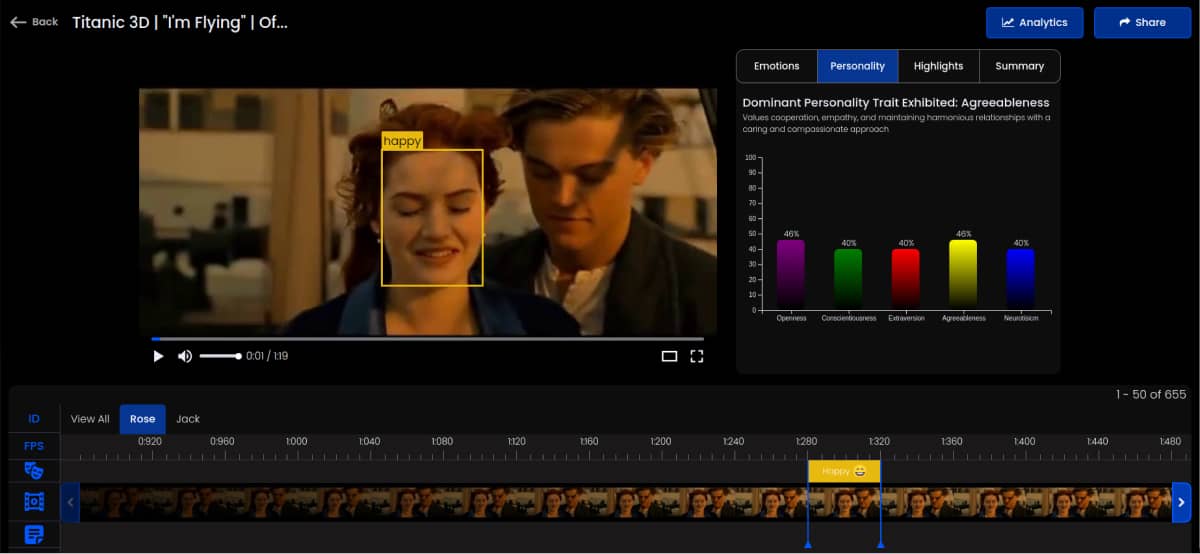
In a video showcasing the personality traits of agreeableness and openness, coupled with a happy emotional tone, the overall impact is one of warmth, positivity, and intellectual engagement. These traits foster friendliness, cooperation, and creative curiosity, making the content inviting and accessible.
The happy tone adds joy and optimism, leaving a positive and uplifting impression. This creates a relatable and emotionally resonant video personality that connects with the audience on both intellectual and emotional levels. It encourages viewers to embrace togetherness, explore new ideas, and bask in the happiness it conveys.
5. The Sixth Sense
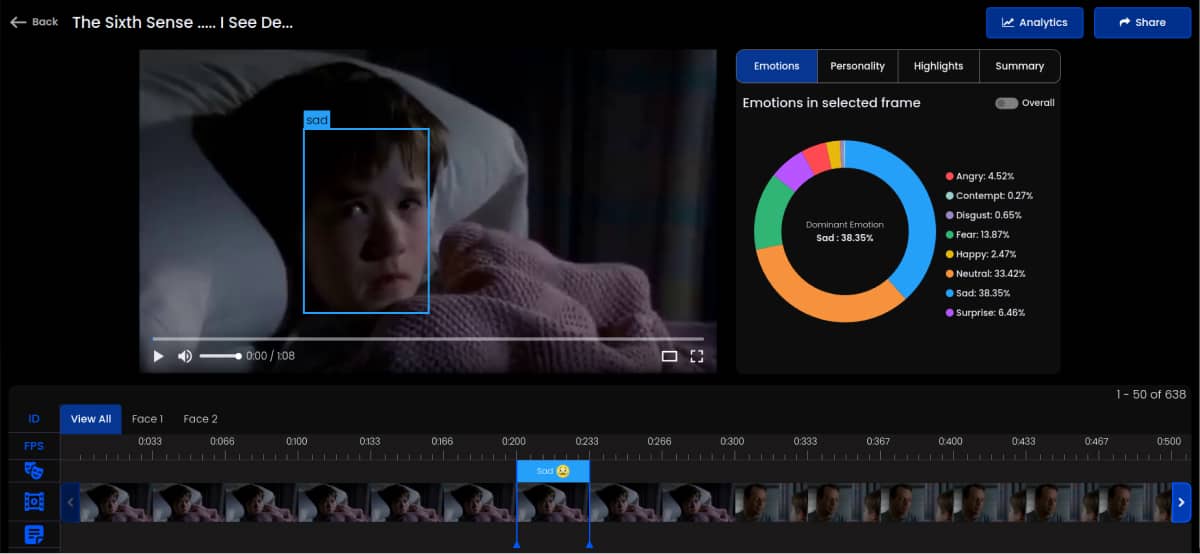
‘The Sixth Sense’ is a thought-provoking cinematic journey that deeply explores human emotions. This psychological thriller navigates themes of fear, grief, and the intricacies of the human psyche, all while examining the profound connection between the living and the departed.
With its compelling narrative, the film resonates with viewers on a personal level, evoking a wide spectrum of emotions and leaving them with lingering thoughts about the mysteries of life and death.
Studies say fear can add depth to the storytelling. It introduces tension and suspense, making the narrative more captivating and memorable. Filmmakers use fear to create plot twists, surprise endings, and thought-provoking themes that stay with viewers long after the credits roll.
In a movie scene, the emotions of sadness and sacredness work together to profoundly impact the viewer's experience. Skillfully portrayed sadness fosters empathy and catharsis, connecting audiences to the characters and drawing them into the story. Meanwhile, sacredness elevates the film's themes, evoking awe and inspiration with deep symbolic meaning. The interplay of these emotions creates a dynamic emotional tapestry that immerses the audience in the narrative and encourages reflection on broader themes and personal beliefs, resulting in a compelling and resonant cinematic experience.
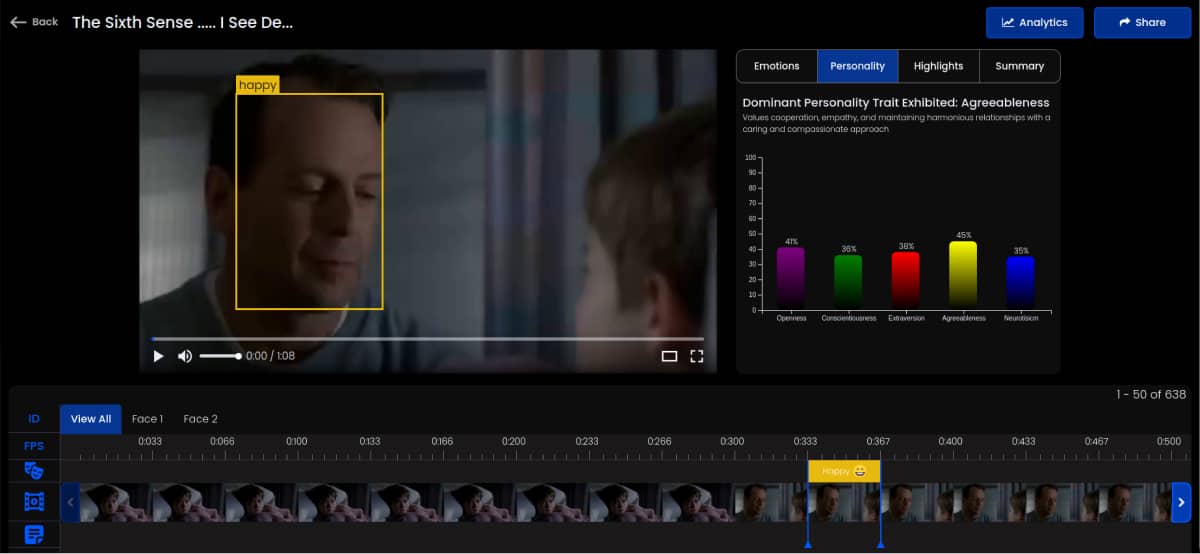
The video's personality shines with high agreeableness and openness. It's kind-hearted and empathetic, aiming to build trust with viewers. Simultaneously, it's open-minded and creative, encouraging a deep dive into emotional complexities. The video's emotional tone is genuine, steering clear of melodrama, offering a safe space for viewers to reflect on sadness. This blend of personality traits creates a deep and authentic connection, appealing to those seeking empathy. The neutral and sad emotional tone allows for a subtle yet profound engagement with the content.
Coming back to visual storytelling in movies, today’s filmmakers are leveraging artificial intelligence in movie production to analyze emotions, psychology, and engagement, making stories more immersive. Through tools provided by Emotion AI technology companies, directors and producers gain deeper insights into characters' emotional arcs, helping them enhance audience experiences and craft memorable cinematic moments.
Stay tuned…
Make your audience feel—Analyze your movie’s emotional depth with us!
(The journey continues in Part 2, as we continue our exploration into movie clips analysis, unveiling more discoveries and insights with Imentiv AI)